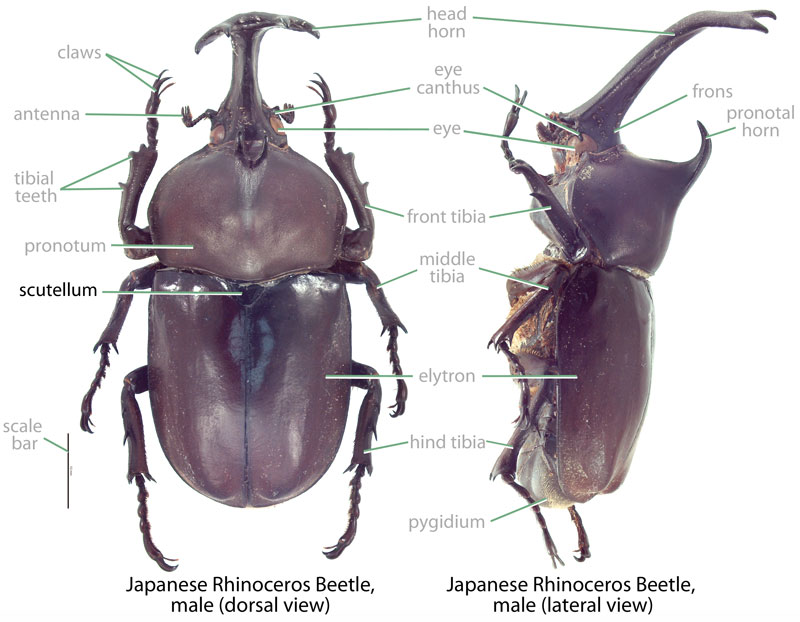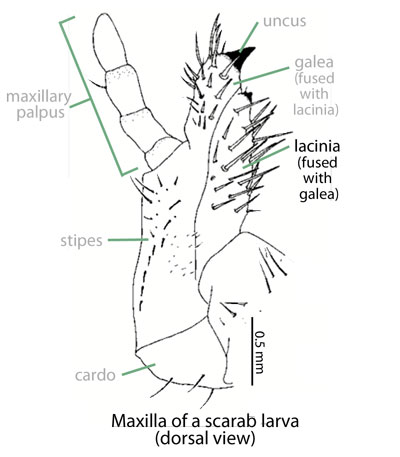Beneficial
brown dung beetle, gazelle scarab, gazelle dung beetle
Family: Scarabaeidae Subfamily: Scarabaeinae Genus: Digitonthophagus Species: Digitonthophagus gazella (Fabricius, 1787)
DNA barcode available: specimen information
Total body length 10.0–13.0 mm (0.39–0.51 in). Body shape oval; may be caked in dung. Color brown to dark-brown; margin of pronotumpronotum:
the dorsal surface of the thorax
 tan. Medium-sized Onthophagus-like dung beetle, more than 10 mm. Clypealclypeal:
tan. Medium-sized Onthophagus-like dung beetle, more than 10 mm. Clypealclypeal:
of, or referring to, the clypeus
apexapex:
point or edge furthest from the body
weakly sinuatesinuate:
gently curved (specifically of margins or edges); often in reference to the clypeus
; not strongly produced in either sex. Head of male with 2 short, upward curving horns at base; minor male with horns reduced or absent; female lacking horns, instead with transversetransverse:
extending horizontally across a surface
ridge. Ocular canthuscanthus:
a process extending over and sometimes dividing the eye
completely dividing eye. Pronotumpronotum:
the dorsal surface of the thorax
 with anterioranterior:
with anterioranterior:
the front or forward; opposite of posterior
angle rounded. Pronotumpronotum:
the dorsal surface of the thorax
 lacking horns; male with weak hump-like process; minor male and female with weak bi-lobedbi-lobed:
lacking horns; male with weak hump-like process; minor male and female with weak bi-lobedbi-lobed:
possessed of two lobe-like structures
process. Tibiatibia:
a segment of the leg articulated with the tarsus and femur
 of male elongated, gracilegracile:
of male elongated, gracilegracile:
thin, slender, light of build
; female tibiatibia:
a segment of the leg articulated with the tarsus and femur
 comparatively stout. Scutellumscutellum:
comparatively stout. Scutellumscutellum:
the triangular portion of the thorax between the bases of the elytra
 absent.
absent.
(Huerta et al., 2010Huerta et al., 2010:
Huerta C, Martinez I, García-Hernández M. 2010. Preimaginal development of Onthophagus incensus Say, 1835 (Coleoptera: Scarabaeidae: Scarabaeinae). The Coleopterists Bulletin 64: 365-371. DOI: 10.1649/0010-065X-64.4.365): Grub C-shaped, hump-backed, cylindrical, and cream-colored. Maxillamaxilla:
set of paired mouthparts located posterior to the mandibles
with galeagalea:
outer branch or lobe of the maxilla
 and lacinialacinia:
and lacinialacinia:
inner portion of the maxilla distinctly separate. Lacinialacinia:
distinctly separate. Lacinialacinia:
inner portion of the maxilla with 2–6 dorsobasal setaesetae:
with 2–6 dorsobasal setaesetae:
small, hair-like structure
. Labium hypopharynx glossaglossa:
paired terminal lobes of the labium
with 9–15 latero-posterior setae; 13–32 setaesetae:
small, hair-like structure
on lateral lobe. Epipharynxepipharynx:
lobe on the interior surface of the labrum or clypeus
with tormaetormae:
in scarab larvae, sclerotized structures on the ends of the clypeolateral suture extending towards the mesal line
united mesallymesally:
at or near midline of body
, anterioranterior:
the front or forward; opposite of posterior
phoba present. Chaetopariachaetoparia:
inner, bristle-covered portion of the paria
 with 10 setaesetae:
with 10 setaesetae:
small, hair-like structure
. setaesetae:
small, hair-like structure
-segmented, distaldistal:
situated away from the point of articulation, thus usually furthest from the body
segment much reduced. Legs 2-segmented. Prothoracic shieldprothoracic shield:
the chitinous plate behind the head of larvae
 without anteriorly projecting processes. Third abdominal segment bearing a prominent conical, dorsaldorsal:
without anteriorly projecting processes. Third abdominal segment bearing a prominent conical, dorsaldorsal:
of or relating to the upper surface; opposite of ventral
gibbosity covered with numerous short, stout setaesetae:
small, hair-like structure
.
Africa. This dung beetle is native to hot, arid, and semi-arid areas of sub-Saharan Africa (Tyndale-Biscoe, 1990Tyndale-Biscoe, 1990:
Tyndale-Biscoe M. 1990. Common dung beetles in pastures of southeastern Australia. CSIRO Publishing, Clayton, Australia.). This species was introduced to Texas in 1970 and has spread (sometimes with deliberate human intervention) throughout much of the southern half of the U.S., southward to Uruguay and Argentina (Noriega et al., 2010Noriega et al., 2010:
Noriega J, Horgan F, Larsen T, Valencia G. 2010. Records of an invasive dung beetle species, Digitonthophagus gazella (Fabricius, 1787) (Coleoptera: Scarabaeidae), in Peru. Acta Zoológica Mexicana 26: 451-456. full text (accessed 2015)). It was introduced to Australia (Tyndale-Biscoe, 1990Tyndale-Biscoe, 1990:
Tyndale-Biscoe M. 1990. Common dung beetles in pastures of southeastern Australia. CSIRO Publishing, Clayton, Australia.).
None. This species feeds on dung as both an adult and larvalarva:
the immature form of an insect; in scarabs, also called grub or white grub; preceded by the egg stage, followed by the pupal stage
 . There are no records of this beetle feeding on live plant tissues.
. There are no records of this beetle feeding on live plant tissues.
(Tyndale-Biscoe, 1990Tyndale-Biscoe, 1990:
Tyndale-Biscoe M. 1990. Common dung beetles in pastures of southeastern Australia. CSIRO Publishing, Clayton, Australia.): Adults of this species live about 2 months, flying from sunrise to sunset in search of dung. In areas of moist, loose soil, females construct a burrow 20–25 cm (7.87–9.84 in) under or near a dung source. The burrow is provisioned with dung formed into oval-shaped brood balls. Each brood ball is impregnated with a single egg. Development from egg to adult can take as little as 3–5 weeks under optimal conditions. Development often takes much longer when the conditions are less favorable. There are multiple generations per year.
None. This species recycles dung and is beneficial for ranching and farming in Hawaii. Primarily being a dung feeder, this species has never been recorded damaging crop or ornamental plants. Additionally, this species is not a threat to native dung beetles because none occur in Hawaii or Guam.
Established. In Hawaii, this species was introduced to Oahu in 1957 (Davis, 1960Davis, 1960:
Davis C. 1960. Recent introductions for biological control in Hawaii—V. Proceedings of the Hawaiian Entomological Society 17: 244-248. full text , DOI (accessed 2015)) and on Big Island in 1973 at Parker Ranch (Nakao et al., 1975Nakao et al., 1975:
Nakao H, Funasaki GY, Davis CJ. 1975. Introductions for biological control in Hawaii, 1973. Proceedings of the Hawaiian Entomological Society 22: 109-112.). Further introductions occurred on Kauai and Maui, though it is unclear if those introductions took place in 1957 or 1973 (Markin and Yoshioka, 1998Markin and Yoshioka, 1998:
Markin G and Yoshioka E. 1998. Biological control of the horn fly, Haematobia irritans L., in Hawai'i (Diptera: Muscidae). Proceedings of the Hawaiian Entomological Society 33: 43-50. full text (accessed 2015)). In much of Hawaii, this species is usually most abundant at lower elevations. It is one of the most common dung beetles on Oahu (Harris et al., 1982Harris et al., 1982:
Harris R, Onaga K, Blume R, Roth J, Summerlin J. 1982. Survey of beneficial insects in undisturbed cattle droppings on Oahu, Hawaii. Proceedings of the Hawaiian Entomological Society 24: 91-95.), Kauai, and Maui (Markin and Yoshioka, 1998Markin and Yoshioka, 1998:
Markin G and Yoshioka E. 1998. Biological control of the horn fly, Haematobia irritans L., in Hawai'i (Diptera: Muscidae). Proceedings of the Hawaiian Entomological Society 33: 43-50. full text (accessed 2015)).
Not established or recorded. There are no records of this species from Guam.
In Hawaii, this species was intentionally imported.
This species could be confused with the similarly colored, medium-sized (more than 10 mm) species: Onthophagus nigriventris and Onthophagus sagittarius.
Major males are readily separated by examining the head armature (D. gazella with 2 short, upward curving horns versus O. nigriventris lacking horns, O. sagittarius with 2 tusk-like horns).
Minor males and females are separated by examining the base of the head (D. gazella with straight, transversetransverse:
extending horizontally across a surface
ridge versus O. nigriventris with a sinuatesinuate:
gently curved (specifically of margins or edges); often in reference to the clypeus
ridge, O. sagittarius with single horn).
Scarabaeus gazella Fabricius, Onthophagus antelope Fabricius, Onthophagus catta Fabricius, Onthophagus dorcas Olivier, Onthophagus gazella Fabricius, Onthophagus intermedius Reiche, Onthophagus metallicus Fabricius
Report your observation of this beneficial species at our iNaturalist project.